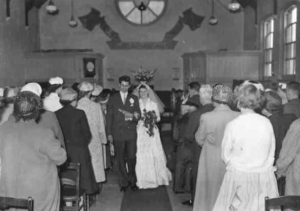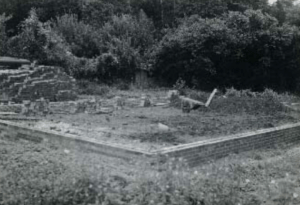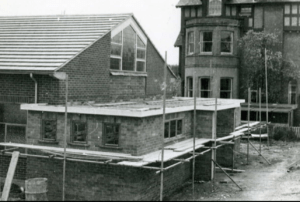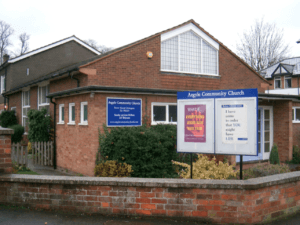Establishment of Bridge Hall, Oxford Road
In the late 19th Century a group of Christians met for some years in a house in Battle Street, which had also been a blacksmith’s shop. As the group grew larger, they realised the need for a dedicated place of worship, and found a plot on the corner of Gower Street on the Oxford Road. On July 5th, 1888, they signed a lease, at the annual rent of £13-19s-0d, to expire in ?1988, the Lessor being a Mrs. Caroline Weldale Saunders of Guildford. A very significant contributor to the work was Sir George Pigot, who was born in 1850 at Newmarket, where his father owned a horse racing stable. He succeeded to the title Baron Pigot in 1891, and was a friend of King Edward VII.
There was already an Exclusive Brethren Assembly meeting in the Queen’s Road Blue Room from 1840 onwards. In I860, Clarence Esme Stuart joined them, and assumed leadership. He was a direct descendant of the Royal House of Stuart of Scotland and England. C.E. Stuart was a very close friend of J. N. Darby, the Bible teacher and writer, who often visited Reading. However, it was considered opportune that a suitable building should be erected, which would help to establish an Open Brethren Meeting in this area of West Reading.
There must have been a strong Sunday School and Young People’s work, because the first plan submitted in December 1888 provided a basement with five classrooms and a play area. Toilets were included, and sloping entrances at each end of the building for boys and girls respectively. For some reason this idea was abandoned, possibly because of cost, and in 1889 an amended plan was submitted, omitting the entire basement accommodation; this application was approved on June 26th, 1889. The Hall was built by W. G. A. Hamblin, a local builder of South Street, and thus Bridge Hall came into being.
The Assembly outreach included visits to the hospitals, and weekly visits to the Casual Ward were made, where “knights of the road” spent a few hours when tramping through the town. Others visited the Doss Houses in the rough quarter of Silver Street, where always two policemen went on patrol.
The Sunday School Treats of those days were events long to be remembered; the races, especially the teachers’ race, caused hilarious laughter. Horses and carts were the means of transport then, and this added to the fun.
A good Youth Work was always maintained in the Assembly. A very good choir was formed, and a number of mixed camps were organised.

Interior of Bridge Hall in 1957
The Move to Argyle Chapel
At the end of WWII G+P Chandler, a building firm had offered to buy a plot of land in Argyle Road for £500, which was initially accepted, then superseded by a higher offer. A Mr Parr bought it and had lived in a caravan on a plot of land on Argyle Road, intending to build a house there, but 14 years later, still no house! Developers had offered to buy the plot, but he always refused.
By 1958 it was realised that Bridge Hall was too small for requirements. Mr. Philip Chandler, a member of the church and a builder visited Mr Parr, proposing that he sell some of the land to build a church. He responded favourably, and agreed to a price of £750, though after further advice raised this to £900, still a good price. A first special offering raised £572, demonstrating the church’s commitment. In the meantime, the church was approached by a solicitor and estate agent, both offering twice the amount paid, but were turned down!

Plot of land in Argyle Road
One very remarkable thing was the discovery by Mr. Parr, on the land, of an old Bible. Up on the bank on the east side stands an old flint building, the date and purpose of which was a bit uncertain. On the inside wall there was a hole, which had been carefully bricked up. This fact had puzzled Mr. Parr for some time – there might be something of value hidden away. It was when the Chapel was being built that he decided to knock the bricks away and find the answer. Imagine his surprise when, wrapped in old newsprint, he pulled out a large 1771 Family Bible. Thinking that it might be of some value because of its age, two or three days later he took it to a dealer to sell for him. It was while he was thinking things over, alone in his caravan – the new Church, the old Bible, that he suddenly connected the two. If it was still unsold, he would fetch it back and present it to the Fellowship. The next day he did just that, and after giving it a final polish, he passed it on to the Church on his behalf. This is the Bible which is now displayed in the cabinet made for it by “Dovetail Dave” Parton who was a member of the fellowship. As a matter of interest, the old flint building-is now covered by a Preservation Order.
The Chapel was completed and furnished in sixteen months, the total cost being £11,407. An appreciable saving was made by the help of some of the members undertaking the plumbing, and much of the joinery work.

Construction of Argyle Chapel
In October 1959, Argyle Chapel was opened. Many Christians from other churches joined us for the dedication service. The ceremony was led by the late Dr. E. F. Barnardo, and with him on the platform was the late Sir John Laing, from whose Trust we received a very generous donation.
Renamed Argyle Community Church
Whilst the hall had served us well for 50 years, during the early part of the new millennium, we began to feel that it was in need of updating, and the accommodation improved to accommodate our desire to reach out to the community around us. And so, in 2011, after renaming the church Argyle Community Church, and much prayer and planning, we started a building project. Demolishing the very dated entrance hall and toilet block, we replaced it with a much more welcoming entrance foyer, and four new meeting rooms/offices at the front of the church.

Argyle Chapel appearance up to 2011
In addition, the older part of the building was updated with a new kitchen, double glazing, a modern heating system, better insulation etc. The wall between the old kitchen and coffee area was demolished, and joined to a new conservatory, creating a larger, modern Coffee Room. All this under the strap line “Safely Out of Our Depth”, because this project had cost over £800,000 and was a major step of faith. But God who guided us through all this had a plan, and that sum was paid off in late 2016, again with the help of the John Laing Trust and many other generous gifts. We were blessed to have a Christian builder, Michael Tapp and his firm carry out the work to a very high standard.

Argyle Community Church – New building